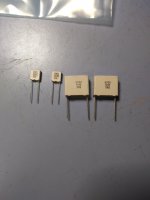Yea, I'm sure the zener is way more noisy then LEDs. Just have limited space on the board. I'll figure something out to fit LEDs. The circuit was from 2008. A lot (of good things) has happened since then. It was pretty respectable for a first generation FET/RIAA stage.
Best practices
I have a couple general questions about signal wiring. First of all, I only use shielded OFC wire in the signal paths. All my applications end with a First Watt clone amp like M2x. My questions are,
1. does it make a difference if you use a terminal block or solder direct to a board. As with the UFSP
2. What is a good wire size (hopefully range) for everything up to the amplifier board. Do you use a different size pre preamp and post preamp
3. What is a good size for the amplifier out signal
4. In general, is it deleterious if it is a little oversized for the actual application, say using 22awg when 26awg would suffice.
Thanks for your thoughts.
Regards,
Don
I have a couple general questions about signal wiring. First of all, I only use shielded OFC wire in the signal paths. All my applications end with a First Watt clone amp like M2x. My questions are,
1. does it make a difference if you use a terminal block or solder direct to a board. As with the UFSP
2. What is a good wire size (hopefully range) for everything up to the amplifier board. Do you use a different size pre preamp and post preamp
3. What is a good size for the amplifier out signal
4. In general, is it deleterious if it is a little oversized for the actual application, say using 22awg when 26awg would suffice.
Thanks for your thoughts.
Regards,
Don
Signal connectors in UFSP are for convenience, wire ends should be tinned before tightened in those. They did not add noise in measurements. Unless wiggled loose. Maybe they will have to be checked & tightened again after enough time. Direct soldering is always the best do it once and forget method of course.
Connectors are also nice to use for a test period until knowing everything works well and steady. Then solder. No need to remove them, can always solder the wires at their pins underneath.
About gauge, whatever is convenient in your configuration. Like bending easily in your box size. Low capacitance coax types are welcome, especially for MM cartridge users at the input route.
Connectors are also nice to use for a test period until knowing everything works well and steady. Then solder. No need to remove them, can always solder the wires at their pins underneath.
About gauge, whatever is convenient in your configuration. Like bending easily in your box size. Low capacitance coax types are welcome, especially for MM cartridge users at the input route.
No I don't remember any member's report having used PPS coupling caps before in some simplistic riaa versionSalas have you had any feedback from someone using PPS caps in C3/C4? I got some Kemet SMR caps on my last Mouser order and thought I'd give them a try in my second UFSP build.
On that topic, I got the 2.2 uF CMR cap now looking for the other position, what cap is the best match for the other position?
Russellc
Russellc
Either its fellow 0.1uF CMR or some top tier Mundorf as I have seen combined in few builds here.
In my opinion the cap between the stages is most critical (C3). I am using a REL polystyrene cap here.
No I don't remember any member's report having used PPS coupling caps before in some simplistic riaa version
Ok, I'll give it a try and report back. I'm going to also get some Clarity CMRs so I have a comparison to the cap du jour.
In my opinion the cap between the stages is most critical (C3). I am using a REL polystyrene cap here.
Which version are you using? It looks like REL makes a few different polystyrene capacitors.
REL RT. I have sonicaps in the RIAA, mostly because you can buy them matched and measured. Output is Jantzen silver but I haven't tried any other caps here.
I've been surprised by caps before...sometimes its counterintuitive and a silmic will sound better than a poly cap in certain places. So it pays to experiment. But I do remember when replacing C3 with the REL RT cap (I think it was a Wima in there before) hearing a distinct improvement and change.
I've been surprised by caps before...sometimes its counterintuitive and a silmic will sound better than a poly cap in certain places. So it pays to experiment. But I do remember when replacing C3 with the REL RT cap (I think it was a Wima in there before) hearing a distinct improvement and change.
I am curious about capacitor matching. As an example, the Jantzen .1uF Z-cap has a 2% tolerance. What do you get with a matched pair?
Thanks,
Don
Thanks,
Don
You get nothing much, C3 C4 are coupling positions, all they can do with tolerance is change the sub LF corner frequency a little between channels. So 2% is super 5% is fine and up to 10% tolerance is still acceptable.
I am curious about capacitor matching. As an example, the Jantzen .1uF Z-cap has a 2% tolerance. What do you get with a matched pair?
Thanks,
Don
I was referring to the caps in the RIAA network where matching and tolerance are important for channel balance and EQ. For coupling, like C3/4 and the output tolerance won't make a difference unless you are WAY off in tolerance.
- Home
- Source & Line
- Analogue Source
- Simplistic NJFET RIAA

